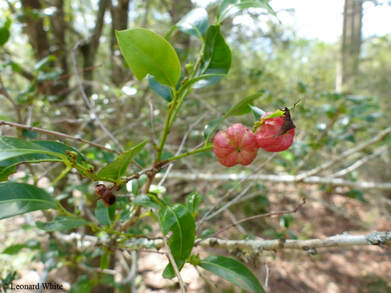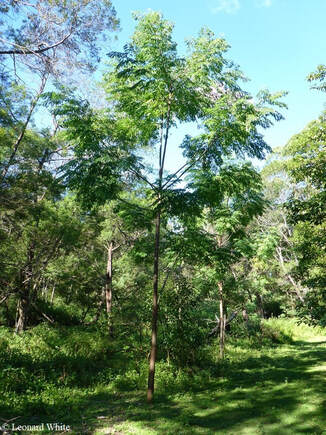|
Common Lilly Pilly (Syzygium smithii)
The Common Lilly Pilly is a rainforest tree that grows to 20 metres. It is an excellent coloniser tree because it is fast growing, has dense foliage and is fairly drought tolerant. The leaf of the Lilly Pilly is teardrop shaped except that the sides curve in toward the middle as it nears the tip. New leaves start deep red before turning pink then dark green as they mature. Lilly Pillys flower in spring. They produce masses of white, hairy flowers which have a passing resemblance to eucalypt flowers. Over summer, the flowers mature into cherry-sized white to pink fruits which are very popular amongst native birds. We use Lilly Pillys extensively for regeneration. They are hardy and ideally suited to areas formerly infested with lantana. Because their seeds sprout wherever they fall, we can simply transplant or pot up the seedlings without going through the first step of germinating the seeds. This makes them even more attractive! Germination: Seed. Grazing resistance: High |


|
Sweet Pittosporum (Pittosporum undulatum)
Pittosporums are an extremely versatile colonisation tree. They are fast growing and highly drought tolerant. Their root system is fairly vigorous and surface roots will often spread well beyond the area covered by the canopy. This makes them perfectly suited to areas where erosion is likely to be a problem. They are so prolific that they are now considered a weed north of the Shoalhaven. Sweet pittosporums can be identified by the waves or undulations along the edge of their oblong leaves. They are a dense tree and can reach up to 15 metres in height. In mid spring to early summer, Pittosporums produce thousands of tiny white flowers at the end of each stem. These flowers emit an extremely strong scent of honey which gives rise to their other common name - Native Mock Orange. By late summer, the small, round seed pods appear. While they start off green, the seeds are not mature until the pod has turned a bright orange colour. We primarily use Pittosporums in areas that we want revegetated really quickly. For instance, in a spot where there are problems with erosion or weed regrowth, we may plant pittosporums to provide a quick cover. Germination: Seed. Grazing resistance: High |
|
Blueberry Ash (Elaeocarpus reticulatus)
The Blueberry Ash is named, quite unsurprisingly, because of the small blue fruits it produces in summer. These follow a mass of small white to pink, bell-shaped flowers with lace-like petals. The Blueberry Ash is a mid-sized tree and rarely exceeds 10 metres. It has dark-green, slightly oval shaped with leaves tiny serrations along the sides. New leaves appear in spring at the tips of each stem and are typically orange to deep red in colour. Although it is technically a rainforest plant, we have found that Blueberry Ashes are actually quite drought tolerant once established and will survive in a variety of soils and conditions. Germination: Seed or Cutting. Grazing resistance: High |
|
Sandpaper Fig (Ficus coronata)
The Sandpaper Fig is most commonly found growing near creeks and gullies. It gets its name from its leaves which feel exactly like sandpaper. Unlike other figs, it is only a mid-sized tree and rarely exceeds 8 metres high. Its leaves are dark green, ovulate shaped and very rigid. The distinguishing feature is obviously the sandpapery texture of both sides of the leaf and the stem. Fruits are the size and colour of purple grapes but are fairly hairy. The Sandpaper Fig is excellent pioneer species and exceptional for erosion control. It has an extensive root system and will tolerate brackish water better than many other native trees. Germination: Seed or Cutting. Grazing resistance: High |
Location |
© 2022
|
